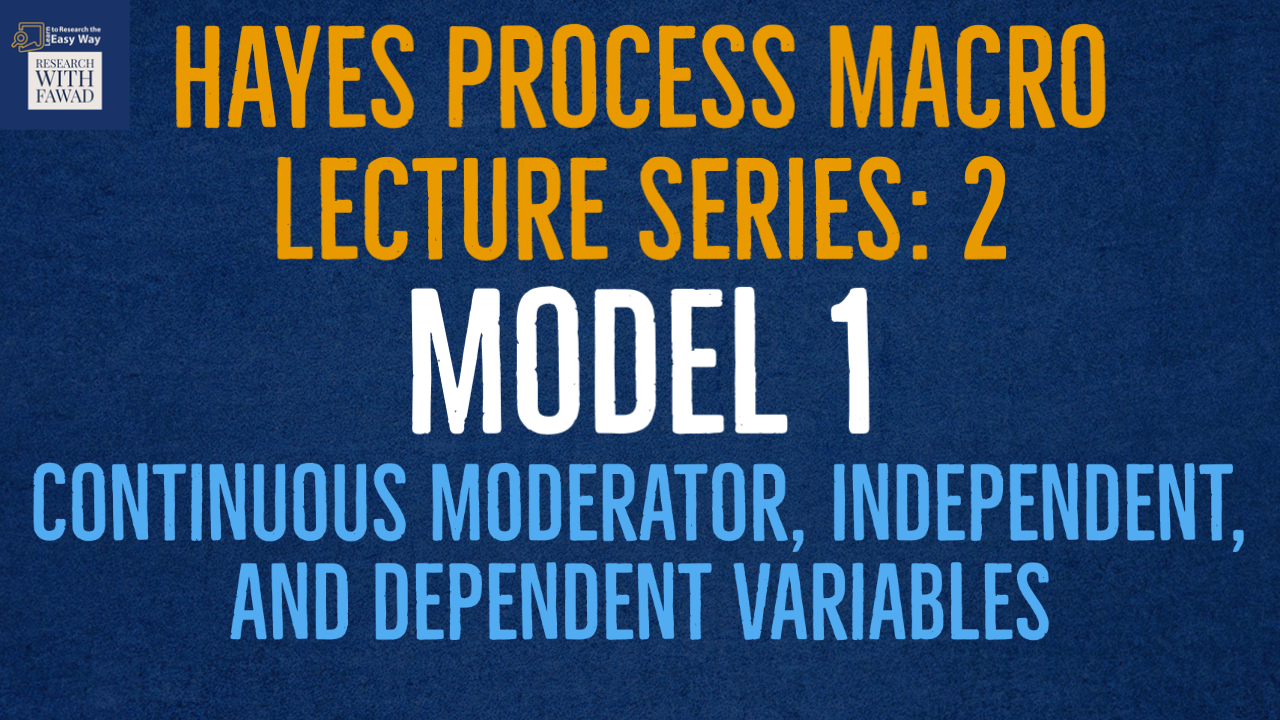Hayes Process Macro - Model 1 - Moderation Analysis with Continuous Moderator

Hayes Process Macro - Lecture Series
The tutorial will guide on Model 1 of the Hayes Process Macro with Moderation Analysis using a Categorical Moderator, Continuous Independent, and Dependent Variables.
Model Index
- All models have one primary IV and one DV. For the purposes of calculation of the indirect effects and conditional effects:
- The primary IV (variable X) is assumed to be continuous or dichotomous
- Moderators (variables W, V, Q, Z) are assumed to be continuous. Can be Categorical as well.
- Mediators (variable M, or M1, M2 etc.) are assumed to be continuous
- The DV (variable Y) is assumed to be continuous and to satisfy the assumptions of standard multiple regression. Can be Binary.
Model 1: 1 Moderator [BASIC MODERATION] Continuous Moderator
- Example Variables: 1 predictor X, 1 moderator W, 1 outcome Y
Preliminary notes:
- Model 1 assumes that:
- The primary IV (variable X) is continuous or dichotomous
- Any moderators (variables W,V,Q,Z) are continuous, though the dichotomous moderators can be handled.
How to Run
- Step 1: Analyze -> Regression -> Process v4.0 by Andrew F. Hayes
Step 2: Put in the Required Variables. In this case,
- Y Variable (Dependent Variable) is OP
- X Variable (Independent Variable) is Culture
- Moderator Variable W: is Role Ambiguity (RA)
- Model Number is 1
- Step 3: Select Option Button, and Choose the options as shown in the figure below ()
- Select Generate code for visualizing interaction, this is to generate graphs for slope analysis
- From Mean center for construction of products groups box, select Only continuous variables that define products. This will mean center the variables the are part of the interaction term. We do mean centering to avoid multi-collinearity between predictor variables and the interaction term.
- From Moderation and conditioning, select -1SD, Mean, and +1SD, for Low, Average, and High level of Moderator.
- Finally, check Johnson-Neyman output, (Described Later in the tutorial).
Output Interpretation - Basic Summary
- The first part of the output is the basic Description of Model along with the different variables where Y is Dependent Variable, X is Independent Variable, and W is the Moderating Variable.
- Model Summary, provides summary of the model with R, R-Sq, F Statistics, and P value for the overall model.
Output Interpretation - Model Summary
- Next, is the coefficients , with impact of Culture, RA, and the interaction effect to assess if there is moderation or not.
- In this example, since the interaction effect is significant, the Role Ambiguity moderates the relationship between Culture and OP
- Test of unconditional interaction, this shows the change in R-Sq due to interaction (x*w), this is also significant.
Johnson-Neyman intervals and simple slopes analysis
- Johnson-Neyman interval tells you the range of values of the moderator in which the slope of the predictor is significant vs. nonsignificant at a specified alpha level
- In simple terms Johnson-Neyman identifies regions in the range of the moderator variable where the effect of the focal predictor on the outcome is statistically significant and not significant.
- In this example, the impact of the moderating variable (RA), on the relationship between focal predictor (Collaborative Culture) and outcome (Organizational Performance) is significant till the value of RA is increased to 2.9281, if further increased there is no moderating effect of RA.
Data Visualization
- Next part of the Hayes Process Macro output is about Data Visualization.
- You will see the following code, to get the graph, copy the code by double clicking on the output.
- Next, Click File menu, New, and then Syntax.
- Paste the Data Visualization code that you copied. Now, Click the Run Selection button.
- You will have the graph with the main output, at the bottom of the Hayes Process Macro original output.
- Originally, the graph will look like the one shown below. However, to make it more meaningful you can connect the dots or make the graph in an Excel Sheet. You can download one here (By James Gaskin).
- I have made the graph like this using the Excel sheet by Jeremy Dawson (Available Here).
Interpretation
- The study assessed the moderating role of Role Ambiguity (RA) on the relationship between Collaborative Culture (CC) and Organizational Performance (OP). The results revealed a negative and significant moderating impact of RA on the relationship between CC and OP (b= -0.095, t = -2.767, p = .006), supporting H1.
- Results of simple slope analysis conducted to better understand the nature of the moderating effects are shown in Figures. As can be seen in Figure, the line is much steeper for Low RA, this shows that at Low level of RA, the impact of CC on OP is much stronger in comparison to high RA. As shown in Figure 2, as the level of RA increased, the strength of the relationship between CC and OP decreased.
Video Tutorial
Additional Hayes Process Macro Tutorials
- Hayes Process Macro – Model 1b – Moderation with Categorical Moderator and Continuous IV and DV
- Hayes Process Macro – Model 2 – Moderation with Two Continuous Moderators
- Hayes Process Macro – Model 4 – Mediation Analysis
- Hayes Process Macro – Model 4 – Mediation Analysis with Multiple Mediators
- Hayes Process Macro – Model 5 – Multiple Mediators and 1 Moderator
- Hayes Process Macro – Model 6 – Serial Mediation
- Hayes Process Macro – Model 7 – Moderated Mediation
- Hayes Process Macro – What is Hayes Process Macro and How to Install it